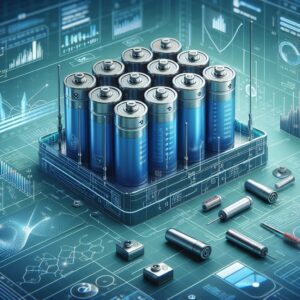Batteries are containers of chemical energy that can be converted into electrical energy when needed. Lead-acid batteries have long been the go-to choice for a myriad of applications, from automobiles to backup power systems, thanks to their reliability and cost-effectiveness. They are not without their drawbacks, including limited energy density and shorter life spans.
Lithium-ion batteries have surged in popularity. With higher energy densities, longer lifespans, and faster recharge rates, they now dominate portable electronics, electric vehicles, and even home energy-storage solutions. The race to enhance lithium-ion technology continues, with incremental improvements in electrode materials and electrolyte formulations enhancing their capacity and safety.
Beyond Lithium
Sodium-ion batteries are emerging as a credible alternative, leveraging the more abundant element sodium over lithium. Sodium is widely available and can be derived from various sources, including seawater, making the raw material for sodium-ion batteries more accessible and potentially less expensive. The basic operating principle of sodium-ion batteries resembles that of their lithium-ion counterparts, with sodium ions moving between the cathode and anode. They face unique challenges, such as lower energy density and slower charge rates, which are areas of intense research and development.
 Nickel-metal hydride (NiMH) batteries offer a balance of reasonable energy density, a lower self-discharge rate, and significant robustness against overcharging. Their capability to withstand a wide range of temperatures and excellent cycle life makes them suitable for various applications, including hybrid electric vehicles. NiMH batteries do not contain toxic metals such as cadmium, which is prevalent in older rechargeable battery technologies, making them a more environmentally friendly option with well-established recycling processes.
Nickel-metal hydride (NiMH) batteries offer a balance of reasonable energy density, a lower self-discharge rate, and significant robustness against overcharging. Their capability to withstand a wide range of temperatures and excellent cycle life makes them suitable for various applications, including hybrid electric vehicles. NiMH batteries do not contain toxic metals such as cadmium, which is prevalent in older rechargeable battery technologies, making them a more environmentally friendly option with well-established recycling processes.
Flow batteries store energy in external liquid electrolyte tanks. These tanks can be scaled up to increase energy capacity, making flow batteries an ideal solution for large-scale energy storage applications like utility grid support and renewable energy integration. The most researched type, the vanadium redox flow battery (VRFB), is compelling due to its long cycle life, fast response times, and minimal degradation over extensive use. The upfront costs and the need for large physical spaces have been hindrances to widespread adoption.
Metal-air batteries employ metals such as aluminum or zinc as the anode and oxygen from the air as the cathode, separated by an electrolyte. Their theoretical energy density is extremely high, making them attractive for extended-range electric vehicles and portable electronics. The challenge lies in overcoming hurdles such as short service life and issues with consistent rechargeability.
By replacing the liquid electrolyte with a solid counterpart, solid-state batteries batteries offer improved safety, higher energy densities, and the promise of longer lifetimes. While they’re still in the developmental phase, solid-state batteries could revolutionize everything from electric vehicles to wearable technology with their superior characteristics.
Compressed Air and Flywheels
Compressed Air Energy Storage (CAES) is a method that captures excess energy, typically during periods of low demand or high production, for later use. It involves storing compressed air in an airtight underground cavern or container and releasing it to generate electricity when demand peaks. The process starts by using an electric motor to power a compressor. The compressor pushes air into the storage vessel at high pressure. When the energy is needed, this high-pressure air is released and expanded through a turbine, generating electricity.
Large amounts of energy can be stored relatively inexpensively, making this method suitable for grid-scale storage applications. This is important when integrating intermittent renewable energy sources like solar or wind, as it helps to stabilize the grid by leveling out the variability in energy supply.
Challenges to the widespread adoption of CAES include finding suitable geological sites for air storage and the efficiency losses during the compression and expansion cycles. Innovations in this field are focusing on improving the overall efficiency of the system, utilizing advanced materials and technology to minimize energy waste during the storage process.
Flywheel Energy Storage Systems (FESS) take a different approach to storing energy. These systems convert electrical energy into kinetic energy, which is stored in the form of a rotating mass. When power is needed, the energy from this spinning mass is converted back into electrical energy via a generator. High-speed flywheels can rotate at speeds of up to 60,000 revolutions per minute and are housed in vacuum-sealed containers to reduce friction and energy loss.
They have rapid charge and discharge cycles, high power densities, long operational lifetimes, and require relatively low maintenance. They can undergo many cycles without experiencing performance degradation, making them ideal for applications where reliability is paramount.
The electric grid operates within a certain frequency range, and deviations from this range can lead to power quality issues or even blackouts. Flywheels can respond swiftly to these changes in demand, releasing or absorbing energy within seconds to help maintain the grid frequency.
The main hurdles for flywheel technology center around cost and energy storage capacity. While flywheels are excellent for short-term energy storage and rapid discharge applications, they are not as effective for long-term energy storage due to energy losses over time.
Harnessing the Power of the Sun and Wind
Thermal energy storage (TES) is an efficient way to store the heat energy captured by solar thermal power plants. Among the different types of TES systems, those involving molten salt are particularly promising due to their high heat capacity and low-cost materials. In this method, solar energy is concentrated using mirrors or lenses to heat a fluid, typically a salt mixture, which can remain in a liquid state at high temperatures. The heated fluid is then stored in insulated tanks and can retain heat for many hours, sometimes days.
 When energy is needed, especially when the sun is not shining, the stored hot fluid is circulated through a heat exchanger to create steam. This steam drives turbines that generate electricity, effectively smoothing out the supply of solar-generated power. With research delving into advanced materials and more refined systems, the efficiency of thermal energy storage continues to increase, making it a viable component of a renewable energy future.
When energy is needed, especially when the sun is not shining, the stored hot fluid is circulated through a heat exchanger to create steam. This steam drives turbines that generate electricity, effectively smoothing out the supply of solar-generated power. With research delving into advanced materials and more refined systems, the efficiency of thermal energy storage continues to increase, making it a viable component of a renewable energy future.
Wind energy conversion systems are highly effective at converting mechanical energy into electricity. The fluctuating nature of wind speed means that energy production is not constant. To counteract this, mechanical energy storage systems like pumped hydro storage are adept at managing the excess energy produced during windy periods.
Pumped hydro storage, one of the oldest and most established forms of mechanical storage uses surplus energy to pump water from a lower-elevation reservoir to one at a higher elevation. When the demand for electricity arises, the stored water is released and flows downhill through turbines, generating electricity as it descends.
Despite its efficiency, the deployment of pumped hydro storage is limited by geographical requirements, such as the need for suitable elevation differences and large bodies of water. Where the landscape allows, pumped hydro serves as a potent solution for large-scale wind energy storage, providing a buffer for the grid and helping to balance supply and demand.